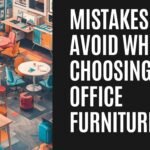How to Choose the Perfect Office Table for Your Workspace
Picking the right office table might seem like a small decision, but it can make a huge difference in how your workspace looks and functions. Whether you’re setting up a new office, refreshing your current setup, or working from home, the right desk can improve productivity, comfort, and even your professional image.
Let’s walk through some simple yet important points to help you choose the perfect office furniture, especially the one piece you’ll be using the most: the office desk.
1. Understand Your Space and Needs
Start by measuring your workspace. How much room do you actually have for a table? A large executive office table might look great, but it won’t be practical if it makes your office feel cramped.
Also, think about how you’ll use the table. Is it for computer work, paperwork, meetings, or all of the above? If you’re setting up a home office, a simple, compact desk might be enough. But if you’re furnishing a manager’s cabin or executive suite, you’ll likely need something more spacious and stylish.
2. Match the Design With Your Office Aesthetic
The design of your office furniture should reflect the overall vibe of your workplace. Is your office modern and minimal, or warm and classic? Your office furniture design should tie everything together.
A sleek metal and glass table might work well in a creative agency, while a solid wood executive office table gives a more traditional, high-end feel, perfect for law firms, consultancies, or leadership offices.
Remember, your workspace speaks volumes about your brand and company culture.
3. Choose Comfort and Function Over Style Alone
Looks do matter but comfort matters more when you’re sitting at a desk for 8+ hours a day. Your office table should be at a comfortable height, offer enough legroom, and provide space for your monitor, keyboard, and other essentials.
Many executive office tables also come with practical features like built-in storage, cable organisers, and even adjustable heights. These small details can make a big difference in your day-to-day comfort and efficiency.
4. Select the Right Material
The material of your office furniture isn’t just about looks it affects durability, weight, and maintenance too. Here are a few common choices:
Wood:
Offers a timeless look and premium feel, great for executive desks and high-traffic offices.
Metal:
Durable and modern, often used in workstations or shared desks.
Laminate or MDF:
Budget-friendly, comes in many finishes, and works well for everyday office setups.
Glass:
Stylish, but can be fragile and may need regular cleaning. Choose a material that matches your style and your day-to-day use.
5. Think About Storage and Organization
A cluttered desk makes for a cluttered mind. Choose an office desk with built-in drawers, shelves, or under-desk cabinets if you need space for files, gadgets, or office supplies.
For senior staff, an executive office table with lockable drawers, cable ports, and wide surfaces not only adds functionality but also gives a sense of authority and professionalism.
6. Balance Cost and Quality
While it’s tempting to go for the lowest price, cheap office furniture can wear out quickly or look out of place in a professional environment. Instead, aim for good value solid materials, thoughtful design, and a good warranty if possible.
Think of it as a long-term investment. A sturdy, well-designed office table can last for years and support your daily workflow without any fuss.
Final Thoughts
Choosing the right office desk isn’t just about filling a space, it’s about creating a comfortable, efficient, and inspiring place to work. From a compact workstation to a bold executive office table, your choice should reflect your needs, your space, and your style. Take the time to find one that fits just right. After all, this is where the real work gets done.
Looking to upgrade your workspace?
Explore a variety of high-quality office furniture options that combine comfort, functionality, and style all designed to help you work better.
Frequently Asked Questions (FAQ)
1. What’s the main difference between a standard office table and an executive office table?
An executive office table is usually bigger, more stylish, and comes with features like built-in drawers or cable organisers. It’s designed for leadership roles and adds a more premium look to the office.
2. How do I pick the right size office table for a small space?
Measure your space first. For smaller areas, go for compact desks (around 36 to 48 inches wide) with vertical storage to make the most of your layout.
3. Which materials are most durable for office desks?
Wood and metal are known for their durability. Laminate is more affordable and available in many styles. Glass looks great, but can be harder to maintain.
4. Are ergonomic features important in an office desk?
Yes! A comfortable height, enough legroom, and features like keyboard trays or monitor stands can make a big difference in long-term comfort and posture.
5. Can I get a custom-designed office desk?
Absolutely. Many furniture stores and manufacturers offer customisation, allowing you to choose your table’s size, finish, storage features, and design to match your overall office furniture design.







Recent Comments